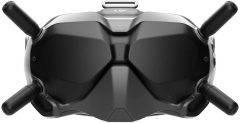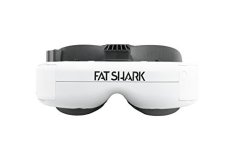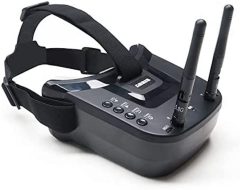BestReviews is reader-supported and may earn an affiliate commission. Details

This is comfortable to wear and is packed with features to give you an immersive viewing experience.
Lightweight and comfortable. HD resolution. Multi-antenna technology for stable video transmission. Video playback on microSD card. Share views with other FPV users. Adjustable frequency channels.
More expensive than other options.

This affordable option is a great choice for beginners and offers many convenient features.
Ultra sensitive receiver. Auto-searching function and working frequency display. Easy to set up. Ergonomic design for comfort. 3.5 hours of battery life. Includes video cable, 2 FPV antennae, USB charging cable, and case.
May not fit over glasses.

These goggles deliver impressive resolution and design and are great for serious drone racers.
Outstanding image quality and 960 x 720 resolution. Fast refresh rate for speedy motion. Comfortable to wear. Has improved user interface for better switching between HDMI and analog feeds.
HDMI port not compatible with all cables.

This product offers high-resolution imagery and is built with adjustable diopters.
39-degree field of view. Selectable image ratio, an expanded display control menu, and a configurable power button. Fully compatible with Shark Byte HD module future-proofing.
Not compatible with FSV2414 when stock receiver is installed.

This product provides clear picture quality and is great for traveling.
Easy to use. Lightweight and compact. Provides double-antenna reception for a stable signal. Ultra sensitive receiver with fast auto-search. Long-lasting and high-capacity lithium-polymer battery.
Not ideal for nearsighted users.

We recommend these products based on an intensive research process that's designed to cut through the noise and find the top products in this space. Guided by experts, we spend hours looking into the factors that matter, to bring you these selections.

First-person view (FPV) goggles offer a remarkable flying experience. You're no longer stuck on the ground looking up at your drone or radio-controlled aircraft; you're right up there in the virtual pilot's seat. Few who've tried it would fly any other way.

Smartphone vs. FPV goggles
The sensation that you're actually flying your drone is an obvious benefit provided by this heads-up display, but there are also some practical considerations.
Smartphone: Streaming video to your smartphone is probably the most common way of seeing what your drone sees, but it's not very convenient. It's practically impossible to see the screen and drone at the same time. Glancing from one to the other can get frustrating, and both smartphones and built-in screens are difficult to see in bright sunlight. Using your phone this way also tends to drain battery power very quickly.
FPV goggles: With FPV goggles, the screen isn't at arm's length – it's just inches from your face. Not only are you getting that bird's-eye view direct from your drone, but the screen also seems much bigger. With most of the ambient light excluded, you get a clearer, more detailed image. Drone racing is an increasingly popular sport for both amateurs and pros. For that kind of flying, good FPV goggles are a must.
VR headset vs. FPV goggles
The cheapest versions of what are often called VR headsets use your smartphone as the screen. You attach it to a tray that slots into the front of the device, thus positioning it in the required heads-up position.
With these devices, it's very important to check compatibility. Often, the phone tray is a separate purchase from the headset. Though at first this seems like a low-cost option, it does tie up your phone for the duration of the flight, and you can't use any of the screen controls. For not much more money, you can buy a dedicated device, which is what we’d recommend.
Type
You'll soon notice that there are two distinct styles of FPV headsets: compact (or slimline) goggles and box goggles. The obvious difference is size, and this is mostly because of the screen.
Compact goggles: These goggles have two separate screens, one for each eye. This is a large part of why they’re smaller, though they aren't necessarily lighter, and they usually command a premium price. If you wear glasses, it's possible to buy diopter lenses for some compact goggles, so you might be able to match your prescription, but they aren't available for all models (and, of course, there's an additional cost).
While we're on the subject of optics, let's mention interpupillary distance (IPD), how far apart your pupils are (in millimeters). If the IPD of slimline FPV goggles is too different from your own, the image can appear blurred or distorted, and you can get eyestrain. Some are fixed at 64mm, which is considered a good average. High-end models are adjustable, and this is by far the better solution.
Box goggles: In box goggles, there's a single screen of between three and five inches. If you wear glasses, you'll probably prefer box goggles, most of which allow plenty of space. IPD isn’t an issue with box-type FPV goggles because your eyes aren't each looking at a separate view.
Image quality
Screen resolution: FPV goggles vary considerably, from basic 320 x 240 pixels, through standard 720p HD to 1080p. One or two premium models now offer high-quality OLED screens for additional brightness and clarity.
Aspect ratio: You also have a choice of aspect ratio, with 4:3 as standard on many and 16:9 as the widescreen alternative. Some goggles can switch between the two.
Field of view (FoV): This is the width of the image captured and it can be anything from 30° to 45°.
Latency: This is the time delay between what's actually happening and the view you see. When FPV goggles first appeared, the latency was often criticized, but anything under 100 milliseconds (ms) is unlikely to cause problems in normal flight, and under 40ms is fast enough for racing.
Digital video recording: DVR lets you record your flights for later playback. Standard recording times can be short, so it's worth checking whether you can extend them with an SD card.
Frequency: Most consumer FPV goggles run at the 5.8 GHz frequency and offer 32 or 40 channels. Many automatically detect your drone/RC aircraft or can be switched manually. Other frequencies are available (2.4 GHz is not uncommon) so check compatibility before ordering.
Aerial: Twin aerial models are designed to provide a more consistent signal and reduce the chances of interference. Omnidirectional aerials are a further enhancement.
Head tracking: This is an advanced feature offered by some FPV goggles (though it also depends on the camera you have). It allows you to control the camera angle simply by moving your head. Instead of turning the drone, you simply look in the direction you want the camera to go!
Battery: All FPV goggles require a battery, but one is not always included. Even when it is, you might need to pay extra for a charger. Some can charge via USB, but it can be painfully slow, taking between four and eight hours depending on the battery size.
HDMI connectivity: This can allow you to use your FPV goggles with PC and TV screens and gaming systems.

Inexpensive: You can get entry-level VR goggles for around $40, though these are the type you need to slot your smartphone into. We'd rather spend an extra ten bucks or so and get a headset with its own screen. There are several between $50 and $80.
Mid-range: Between $100 and $200, you find bigger and better screens and often the ability to record video. Video length depends on onboard memory or the ability to expand it.
Expensive: High-end FPV goggles can offer great comfort, excellent screens, and features like head tracking that make for a truly immersive experience. The investment is considerable, though, with prices rarely under $300 and going up to $500 for the very best FPV headsets.

Q. What's the difference between FPV and VR goggles and headsets?
A. This whole area can be very confusing, and it isn’t helped by rapidly changing technology. Many experts define virtual reality goggles as low-cost consumer items and first-person view headsets as high-end devices for drone racers, though it's often hard to define boundaries between the two. In general use, they’ve both become names for the same device. We think it's much more important to concentrate on the capabilities than on whether it's called VR or FPV.
Q. Can FPV goggles be used with TVs, laptops, and game consoles?
A. It depends on the model. If you can run an HDMI cable between the two it should work, though it's a good idea to check with the manufacturer.
Q. Are FPV goggles safe? Can they damage your eyesight?
A. We're not qualified to give a medical opinion, so we can only pass on the results of our research. Experienced users, testers, and racers report no ill effects, though all avoid prolonged use. Proper IPD is highly recommended to minimize vision issues. Some people experience momentary dizziness after removing the goggles as their eyes readjust. It's not recommended that you remove the goggles mid-flight because it can cause loss of control of your drone.
Get emails you’ll love.
Learn about the products you’re wondering if you should buy and get advice on using your latest purchases.
